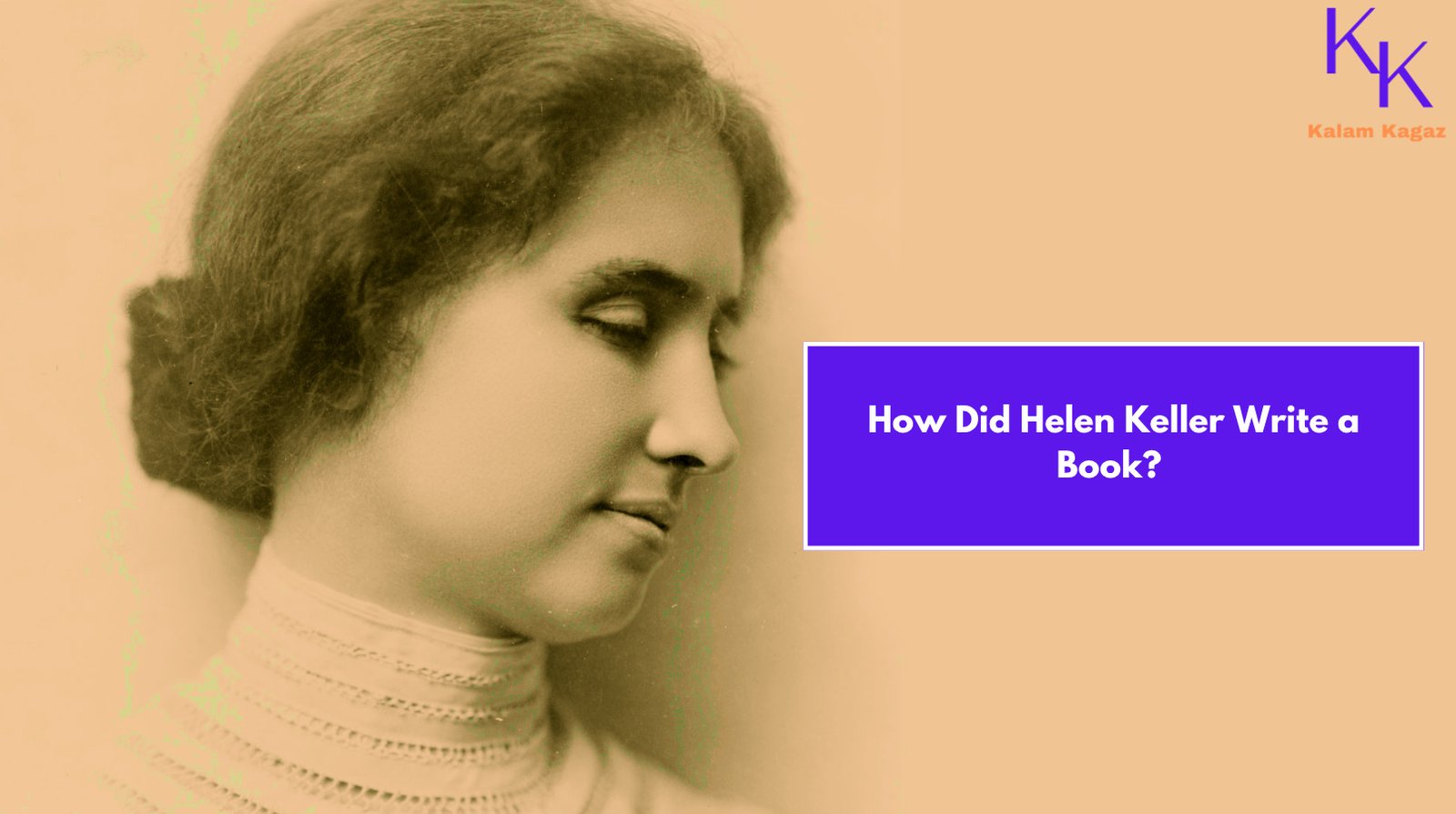- June 19, 2025
- by Kalam Kagaz
- book publishing, Case Study, Ghost writing
Imagine trying to write a book without ever seeing a page or hearing a word. No screen readers. No audiobooks. Just memory, touch, and thought.
Now imagine doing it in the early 1900s.
That was Helen Keller’s reality. Born in 1880 and left deaf and blind by illness before age two, Helen Keller didn’t just learn to communicate—she mastered language, became a college graduate, and authored over a dozen books.
So how did Helen Keller write a book?
This blog answers that in full: not just yes, but how, with what tools, and under what conditions. We’ll explore the methods she used, the people who supported her, the technology available to her, and the lasting legacy her writing left on disability rights and global literature.
Let’s go back to where words were silent and language was felt.
2. Life Before Words: A Child Locked Inside
Helen Adams Keller was born in Tuscumbia, Alabama. She was a healthy baby, active and alert. But at 19 months, she fell ill—most likely scarlet fever or meningitis. She survived, but the illness left her deaf and blind.
Imagine the confusion: a toddler who can no longer see her mother’s face or hear her voice. She became frustrated and wild. She lashed out. With no way to express herself or understand the world, Helen was stuck inside her own mind.
By age six, she had created over 60 home-sign gestures, trying to communicate. But it wasn’t enough. Her parents, desperate to reach her, searched for help.
They found it in a young teacher named Anne Sullivan.
3. Anne Sullivan: The Woman Who Unlocked a Mind
Anne Sullivan was only 20 when she arrived in Tuscumbia. She was half-blind herself and a graduate of the Perkins School for the Blind. But she saw something in Helen that few others did: potential.
She didn’t pity Helen. She challenged her.
Anne began spelling words into Helen’s hand—first “doll,” then “cake.” But Helen didn’t understand. Words had no meaning for her, until one breakthrough moment.
At the water pump, Anne spelled W-A-T-E-R into Helen’s palm while cool water flowed over the other hand. Suddenly, something clicked. Helen “felt a misty consciousness as of something forgotten—a thrill of returning thought,” as she later wrote.
That moment changed everything.
It was the first time she realized that every object had a name, and those names could be shared.
4. Learning to Read and Write: Braille, Slates, and More
Helen was hungry to learn. Once she grasped the idea of words, she picked up language quickly. But how does a deaf-blind person read?
Braille became her doorway to the written word. Helen learned to read raised dots with her fingers. Her teachers provided her with Braille books, and she used a Braille slate and stylus to write. This involved punching tiny holes into thick paper to form the Braille alphabet.
Later, she mastered the Braille typewriter—specifically the Hall Braille Writer, which allowed faster writing.
Helen also learned to use a standard typewriter. Her keys were marked tactically so she could feel the layout. She could type in English with surprising speed and accuracy, and without assistance.
This allowed her to independently produce manuscripts, letters, and articles.
5. From Thought to Page: Helen’s Writing Process
Now to the big question: How did Helen Keller write a book?
Her process was multi-step:
Mental Composition – Helen mentally composed whole paragraphs and chapters. She would often “write” the draft in her mind before touching a typewriter.
Braille Drafting – Using her Braille slate or Hall Braille Writer, she would draft sections tactilely.
Manual Typing – With her labeled typewriter, Helen typed out final versions of her writing.
Proofing and Editing – Anne Sullivan, and later others like Polly Thomson and John Macy, read the drafts back to her through tactile sign language or fingerspelling, enabling her to revise.
Final Manuscripts – These were submitted to publishers. She personally approved every change.
She relied on memory, structure, and a remarkable internal sense of rhythm. Her discipline rivaled that of any modern author.
6. Her Team of Collaborators: Guiding, Not Ghostwriting
While Helen was the author, she had help.
Anne Sullivan helped translate thoughts between touch and text.
John Macy, her early editor (and Anne’s husband), offered stylistic guidance.
Polly Thomson, her later secretary, helped with correspondence and dictation.
But these were collaborators, not ghostwriters. Helen remained in control of content, tone, and structure. She approved everything before submission.
She didn’t need someone to write for her. And She needed someone to read back what she had already written in silence.
7. The Story of My Life – Her First Bestseller
At age 22, Helen Keller published her first book, The Story of My Life (1903). It began as a series of articles in Ladies’ Home Journal, later compiled and expanded.
The memoir traced her early life, her breakthrough at the pump, and her journey through formal education.
The book was a hit.
Critics praised it for its clarity, depth, and emotional power. Readers were astonished by her honesty and intellect. Today, it’s a literary classic, translated into over 50 languages and taught in classrooms around the world.
8. More Than a Memoir: 13 More Books and Hundreds of Essays
Helen didn’t stop after her autobiography. She went on to write:
The World I Live In (1908)
Out of the Dark (1913)
Midstream (1929)
Let Us Have Faith (1940)
Teacher: Anne Sullivan Macy (1955)
And many more.
She also wrote essays on politics, disability, education, and spirituality. Her writings were published in The Atlantic, The New Republic, and The New York Times.
By the end of her life, she had written 14 books and over 500 essays and letters.
9. Her Political Voice: Socialist, Pacifist, Feminist
Helen Keller wasn’t just a gentle soul. She was radical.
She was a member of the Socialist Party of America, supporting labor rights and criticizing capitalism. Also wrote about poverty, industrial exploitation, and racism.
In Out of the Dark, she expressed strong political views that shocked many of her admirers. Some newspapers that once celebrated her now called her “misguided.”
But she never backed down.
She supported women’s suffrage, birth control, and civil rights—decades before it was fashionable. Her writing wasn’t just poetic; it was provocative.
10. Advocating for the Blind: The AFB Years
Helen joined the American Foundation for the Blind (AFB) in 1924 and worked with them for over 40 years.
Her focus? Accessibility.
She promoted Braille books, the development of audio books (then called “talking books”), and vocational training for blind workers.
She visited 35 countries, met 12 U.S. Presidents, and lobbied for inclusive laws. Her writing became a tool for global advocacy, not just literature.
She truly believed that disability didn’t mean inability. And she proved it—again and again.
11. Tools and Technology Helen Used
Here are some of the tools Helen used to write her books:
Braille Slate and Stylus
Hall Braille Writer
Manual Typewriter with tactile markers
Raised-letter books
Tactile alphabet (hand-spelled letters)
Fingerspelling and palm-writing for editing assistance
Each tool gave her independence and control. These methods laid the foundation for accessible writing tools today.
12. Cultural Legacy: Beyond Books and into History
Helen Keller became a cultural icon.
Her life inspired the Broadway play The Miracle Worker (1959) and the Oscar-winning film (1962). Countless documentaries and books have been made about her.
In India, the movie Black (2005) drew from her story. Helen Keller Day is celebrated on June 27, her birthday, across the U.S. and beyond.
Today, her story is still used in motivational talks, disability awareness campaigns, and classrooms worldwide.
Conclusion: Her Voice Still Speaks
In today’s world of AI writing tools, voice-to-text apps, and screen readers, Helen Keller’s journey reminds us of something essential:
Writing is more than typing. It’s thinking. It’s feeling. It’s imagining something no one else can see—and bringing it to life.
She didn’t just overcome disability—she redefined what it meant to be human, curious, and brave. Her story challenges every excuse we’ve ever made about what we can’t do.
So the next time you wonder how to start your book, remember Helen Keller.
She started hers in total silence—and still made the world listen.
FAQs
Did Helen Keller write a book?
Yes. She wrote 14 books and hundreds of essays, starting with The Story of My Life in 1903.
How did Helen Keller write a book?
Through Braille, typewriters, memory, and tactile feedback. She mentally composed ideas, wrote in Braille, typed independently, and revised with assistance.
How did Helen Keller wrote a book?
Despite the grammatical phrasing, the answer is: she used her fingers, tools, and mind to craft full manuscripts without hearing or seeing.






